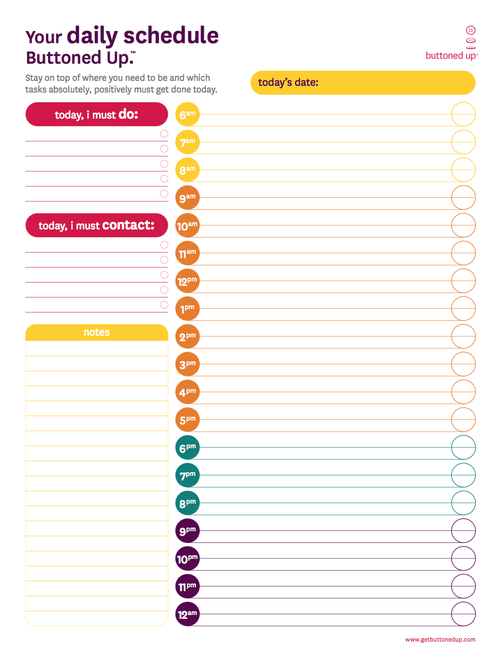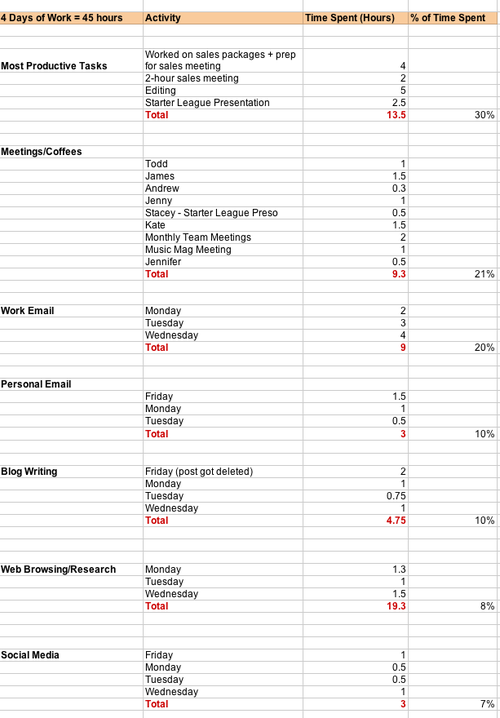If you’re struggling right now with time management and are looking for a simpler, more effective system, I’ve got one for you. I’ll talk about various different parts of the system this week, but let’s start with fixing what’s broken first.
I’m convinced there are two major reasons why people don’t create and follow systems that work:
Problem #1: Most people have no idea how they’re spending their time.
It’s the same thing with a diet. A ton of people track their diets. Why? Because you’re a lot more likely to intake fewer calories and eat less crap if you’re tracking exactly what you’re eating.
Well, the same is true for tracking how you spend your time—except pretty much nobody does it. And everyone really should—at least quarterly. We all have a sense of how and why we’re being unproductive (i.e. too much time on social media, on email, getting ready in the morning, browsing the web, in meetings, etc.). But, I promise you, unless you’re already super productive (in which case, I don’t know why you’re still reading this), you will be shocked by how much time you’re actually wasting on stuff that isn’t really important. So, here’s the first thing I want you to do:
Solution #1: For the next 7 days, assess how you’re spending your time.
Here’s the sheet I use to keep track of my schedule. I like this one below (mostly because it’s colorful), but you can search and find a ton of others. If you do want to use this one, you can find the original PDF here. Print out 7 copies—one for each day.

A few tweaks I make to the spreadsheet:
- I don’t really use the “I must do” or “I must contact” sections on the left-hand side, but feel free to use them if they’re helpful to you.
- I turn the “Notes” section into a “Triggers” section.
So, what are “triggers”?
Triggers are basically anything that causes you to switch from doing something productive (and single-tasking), to doing something less productive or off-task. Examples: If I’m editing an article and a thought pops into my head that I need to look for a new iPad cover, that thought bubble is a trigger for me. If I’m batch-tasking my emails and a colleague leans over to start a conversation, that colleague is a trigger, too.
Triggers can range from a thought to a phone call, or an email to a link in an article you’re reading. As you record your days for one week, get in the habit of recognizing your triggers, and be as specific as possible when you record what they are. Understanding what they are will help you figure out how to temper or eradicate them later.
As you record your week, here are a few good tools for keeping you focused and energized:
- Pomodoro Technique. This helps you work in bursts of 25 minutes, with a mandatory 5 minute break. You can adjust the timeframes, but this technique is essentially supposed to help you sustain your energy all day.
- Rescue Time. Everyone from Neil Patel to Tim Ferriss raves about this, but the really useful version costs money. If you’re willing to invest, it’s a great tool.
- Task Timer. This is a Chrome plug-in. I use it to help me determine how long it’s really taking me to do batch tasks and my most impact-critical tasks.
Warning: A quick word of warning about tracking your time. It’s very easy to forget to track things in detail. I’d set a recurring reminder on your calendar every hour so you can take 2-3 minutes to track what you’ve done for the past hour. Otherwise, you’ll get lost in a task, not record what you did for 3-4 hours at a time, and your data won’t be that detailed or useful. So, use a calendar reminder every hour for the next week! I promise, it’s not as annoying as it sounds.
Problem #2: We don’t take enough time to assess results and figure out how to do more of what’s working.
Obviously, if we’re not even taking time to track how we’re spending our time, we’re certainly not maximizing the learnings we could get from analyzing our results and figuring out what’s driving them. So that’s the next thing I want you to do:
Solution #2: Assess your schedule for the week.
Once you’ve got an entire week’s worth of data on how you spent your time, put your tasks into different activity buckets. Examples:
- Social media
- Checking work email
- Checking personal email
- Writing blogs
- Strategic planning
- Meetings
- Sales calls
- Travel
- Relaxation time
- Web browsing
- News reading
- Getting ready for work
- Preparing meals
- Etc.
Then, come up with a percentage of time spent on each activity given the number of hours you are “at work” per week. Here’s what a portion of my work assessment looked like, so you get a sense of how to put your own together:

Though it was a slightly atypical week, quite frankly, I was still shocked by how much of my week I spent in meetings and in my inbox. Once I put this analysis together, I could very clearly see my problem areas, and then know exactly where I needed to develop more efficient systems for myself.
Finally, answer this question:
What 20% is driving 80% of your results?
This question is based on the Pareto Principle, which states that, for many events, roughly 80% of the effects come from 20% of the causes.
So, determine what 20% of your work is driving 80% of your results, and what 80% of your work is driving 20% of the results. Create a two-column chart for the highest and lowest results-driven behaviors.
The tasks under my “Most Productive” tab generated a high return on investment for me. Those are my “20%” tasks (you can tweak this number for whatever works—could be 10/90 or 30/70 for you). Later this week, we’ll talk about how to spend more time fitting your high-productivity tasks into your schedule so that you have more time to do those things instead of the time-wasters that suck up 70-90% of your time.
As an aside, I know we all spend a lot of time browsing the web and consuming news, which I am going to guess is a bit of a time suck for everyone reading this. Here’s a great mini e-book from Tim Ferriss about putting yourself on a low-information diet.
Hope you’ll share this with anyone who could get use out of it.


